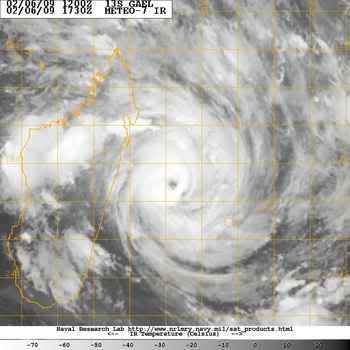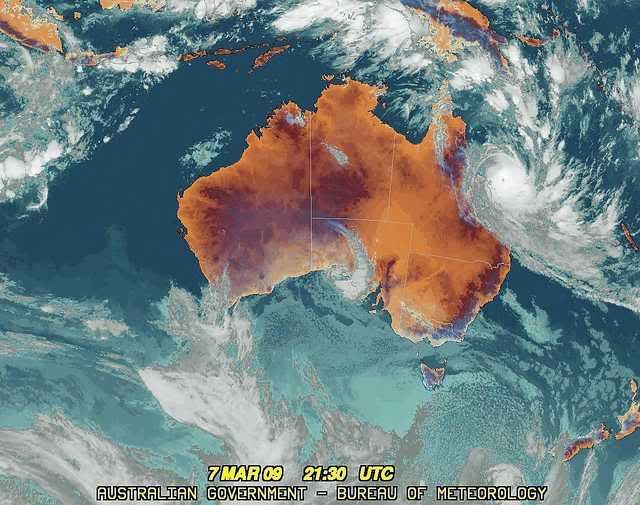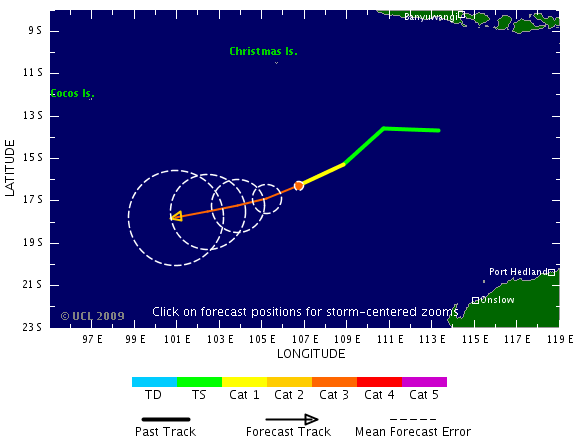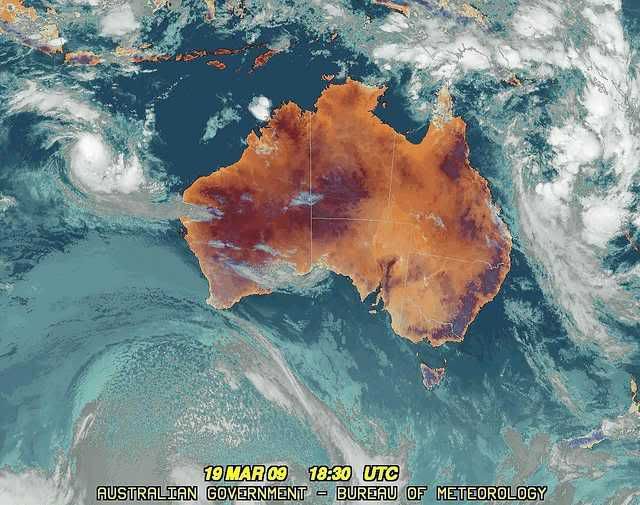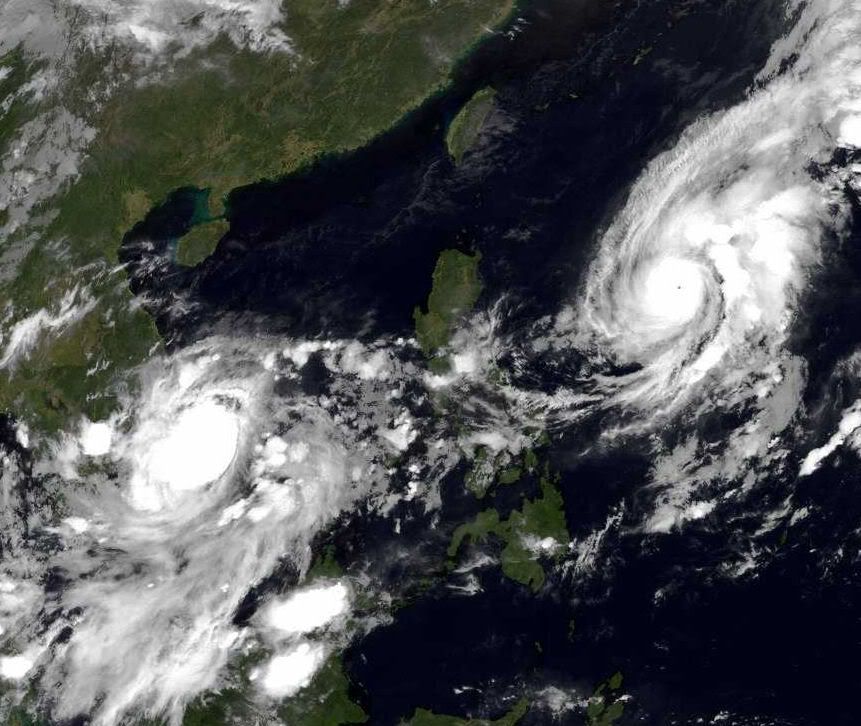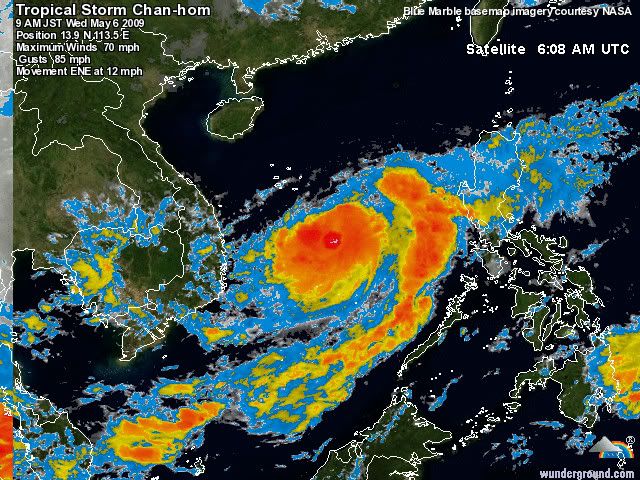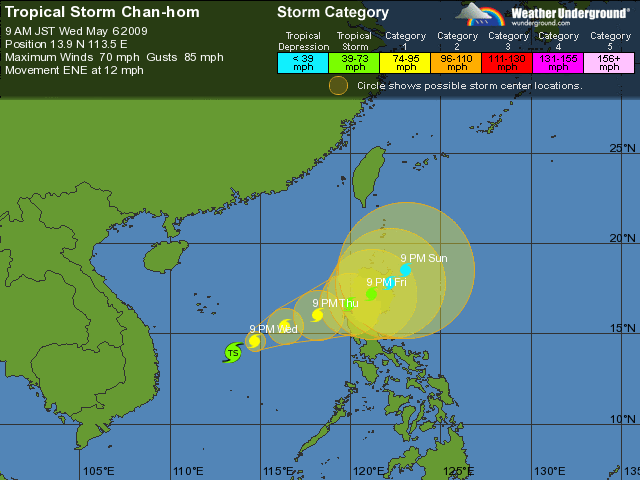WKN Weer, Klimaat en Natuurrampen
Lees alles over het onstuimige weer op onze planeet, volg orkanen en tornado's, zie hoe vulkanen uitbarsten en hoe Moeder Aarde beeft bij een aardbeving. Alles over de verwoestende kracht van onze planeet en tal van andere natuurverschijnselen.




Hier is dan het eerste deel van Hurricane Season 2009 voor alle tropische stormen ter wereld. Voor zowel Atlantische, Indische als Pacifische stormen kan je hier terecht
Algemene Info
Met de term 'Hurricane Season' bedoelden we in eerste instante de periode van 1 juni tot 30 november.
Deze periode wordt in het Atlantische basin en de Golf van Mexico gezien als het Stormen-seizoen. Echter komen deze geweldadige stormen overal in de wereld voor en met name in AziŽ zorgen ze jaarlijks voor duizenden slachtoffers en tienduizenden daklozen. Echter horen we vaak erg weinig over de stormen in AziŽ en juist meer over die in de VS.
In de laatste jaren zijn Tropische Stormen meer en meer in de media gekomen. Het lijkt ook alsof ze meer en meer slachtoffers maken. Een documentaire over Hurricane Andrew uit 1992, heeft diepe indruk gemaakt en ook zullen kenners orkanen Floyd, Gilbert, Stan en Ivan zich zeker nog herinneren. De catastrofe die "Katrina" met zich meebracht ging de hele wereld over. En dan praten we eigenlijk alleen over de Atlantische stormen en lijken we te vergeten dat er in 2007 meer dan 4000 doden vielen in Bangladesh door orkaan Sidr en orkaan Nargis zorgde voor 80.000 doden in Myanmar alleen al.
Hoewel het Atlantische seizoen pas officieel in juni begint zijn er op andere plekken in de wereld zeker meer orkanen te vinden in de komende maanden. We zullen ook deze dus zeker gaan bespreken. Waarschijnlijk zal de kern van de discussie en de posts gaan over de periode 1-6-2008 t/m 30-11-2008. T.z.t. zal er ook wel een NWS-topic worden geopend als een orkaan ook uitgebreid in het nieuws komt.
Orkanen: Hoe ontstaan ze eigenlijk?
op de site van Wikipedia kan je in het Nederlands nalezen hoe ze ontstaan en wat de belangrijkste energiebron is voor hun verwoestende kracht: het warme zeewater
Ook de BBC heeft er een interessante en leuke animatie over gemaakt.
Ook wordt er op LiveScience in het engels prima uitgelegd hoe ze ontstaan en zich ontwikkelen
Indeling en Kracht
De stormen worden ingedeeld op 'categorie'. Vaak zijn het eerst tropische stormen" (Tropical Depression, Tropical Storms), die overgaan op Orkaanstatus (Hurricane/Tyfoons) Ze worden ingedeeld op windsnelheden via de Saffir-Simpson Schaal
Tropical Depression 24-38 mph winds (38-61 km/u)
Tropical Storm 39-73 mph winds (62-118 km/u)
Hurricane Categorie 1 74-95 mph winds (119-153 km/u) -- 4/5 ft Storm Surge -- Vb. Danny 1997, Stan 2005
Hurricane Categorie 2 96-110 mph winds (154-177 km/u) - 6/8 ft Storm Surge -- Vb. Danielle 2004
Hurricane Categorie 3 111-130 mph winds (178-209 km/u) - 9/12 ft Storm Surge - Vb.Fran 1996, Beta 2005
Hurricane Categorie 4 131-155 mph winds (210-249 km/u) - 13/18 ft Storm Surge - Vb.Hugo 1989, Frances 2004
Hurricane Categorie 5 > 156 mph winds (meer dan 250 km/u) -- 18ft or more S.S. -- Vb.Andrew 1992, Mitch 1998 en Wilma, Katrina 2005
TIP: Interactief (film0overzicht van de krachten van orkanen nav de schaal van Simpson
Waarom hebben orkanen namen?
De Tropische Depressies worden overal ter wereld in de gaten gehouden en zodra de depressies uitgroeien tot orkaan of cycloon, wordt er een naam aan de storm gegeven. Sinds 1950 krijgen ze namen op alfabetische volgorde (met uitzondering van de letters Q, U, X, Y en Z). Mocht een orkaan vernietigend hebben huisgehouden zoals Floyd, Gilbert en bijv. Katrina, dan zal die naam worden vervangen. Soms komt het ook voor dat alle letters van het alfabet gebruikt zijn in ťťn seizoen (zoals 2005), dan zal een volgende storm Alpha gaan heten, gevolgd door Beta etc etc. Voor het orkanenseizoen 2009 zijn de namen als volgt:
Atlantische Stormen 2009
Ana, Bill, Claudette, Danny, Erika, Fred, Grace, Henri, Ida, Joaquin, Kate, Larry, Mindy, Nicholas, Odette, Peter, Rose, Sam, Teresa, Victor, Wanda
In het Noordoosten van de pacific ontstaan ook orkanen. Deze zorgen meestal voor weinig schade aan de Amerikaanse/Mexicaanse westkust.
Oost Pacifische Stormen 2009
Andres, Blanca, Carlos, Dolores, Enrique, Felicia, Guillermo, Hilda, Ignacio, Jimena, Kevin, Linda, Marty, Nora, Olaf, Patricia, Rick, Sandra, Terry, Vivian, Waldo, Xina, York, Zelda
Verder zijn er dan nog de stormen in het Noorden, Zuiden en Westen van de Pacific. Daar worden ze tyfoons en/of cyclonen genoemd. Met name de stormen in het Noord/Westen komen vaak in het nieuws omdat ze Japan, de Filipijnen, Taiwan en China vaak teisteren, maar ook geheel Zuid Oost Azie kunnen treffen. Meer informatie over de namen van deze stormenvind je hier.
Leuk hoor, maar wanneer zijn die orkaanseizoenen nou precies?
ATLANTISCHE OCEAAN: 1 juni t/m 30 november
NOORD OOST PACIFIC:Begin mei t/m begin November, met piek in Augustus/September
NOORD WEST PACIFIC: Begin juli t/m eind November, maar eigenlijk hele jaar door aktiviteit.
NOORD INDISCHE OCEAAN: April t/m December met pieken in Mei en November
ZUID INDISCHE + WEST AUSTRALISCHE OCEAAN: Oktober t/m Mei met pieken in Februari en April
ZUID WEST PACIFIC + OOST AUSTRALISCHE OCEAAN: Oktober tot eind April met piek in Februari.
Over het algemeen is Mei de rustigste maand en September de zwaarste.
Ennuh, hoe ziet die voorspelling er voor 2009 dan uit?
50 jaar Hurricane Seizoen hebben een gemiddeld orkaanseizoen gecreŽerd. 9,6 stormen krijgen een naam, 5,9 stormen groeien uit tot orkaan en 2,3 orkanen worden superorkanen.(cat 4/5)
Volgens Phil Klotzbach en William Gray van CSU wordt 2009 een relatief druk orkaanseizoen. Volgens hun is er 63 procent kans dat een superorkaan in 2009 de VS kust zal treffen. Meer over de voorspelling voor 2009 en die van 2008 kan je hier lezen
Oude Delen
2004 - Deel 1 en Deel 2
2005 - Deel 1 en Deel 2
2006 - Deel 1 en Deel 2
2007 - Deel 1, Deel 2, Deel 3 en Deel 4
2008 - Deel 1 en Deel 2
Enkele Links
1. National Hurricane Centre
2. Carribean Storm Network
3. Hurricanezone
4. Hurricane Track
5. Website met satelietbeelden van de Caribbean en de rest van Amerika
6. Intellicast: Geavanceerde satellietfoto's en gifs van aktuele stormen
7. Tropical Weather Underground
8. Tropical Storm Risico's van dit moment
9. Wikipedia Hurricanes/Tyfonen in het algemeen
10. Alle stormen ter wereld van de laatste jaren in overzicht
11. The StormTrack
12. Orkanensite in de Filipijnen
13. Atlantische Orkanensite
14. Actuele orkanen in AustraliŽ en De orkaanindeling in AustraliŽ
15. Tropische weersite omgeving AustraliŽ
16. Mooie site over Orkanen aan de VS kusten
17. Website van NASA over Hurricanes
Opmerkelijke Wikipedia-Links
-- Hurricane Katrina 2005
-- Cyclone Nargis 2008
-- Hurricane Season 2008 - Wikipedia
-- Hurricane Season 2007 - Wikipedia
-- Hurricane Season 2006 - Wikipedia
-- Hurricane Season 2005 - Wikipedia
-- Hurricane Season 2004 - Wikipedia
Actuele Weerradar in Golf van Mexico
Actuele Water temperatuur.
=====================
Post hier je gegevens, berichten, data en opmerkelijke zaken over Orkanen, Tyfoons en Hurricanes en van 2009
[ Bericht 0% gewijzigd door Frutsel op 27-08-2009 12:10:19 ]


Nu wel, thxquote:Op maandag 12 januari 2009 22:49 schreef aloa het volgende:
Staat deze site er ook tussen?
Current Tropical Cyclones Australie


Onderstaande link is ook wel handig. In Australie gebruiken ze weer een andere indeling, dan in Amerika of Azie.
categorie/indeling
categorie/indeling


Veel schade in Madagascar door Fanele.
Overstromingen en enorme stormschade.
Overstromingen en enorme stormschade.
quote:TROPICAL STORM "ERIC"
Tropical storm "Eric" descended on the regions of Sofia, Sava, Atsinanana, and Analanjirofo in the north-east of Madagascar at 8 am on 19 January 2009, carrying heavy rain and winds at the speed of up to 95 km/h. Landing in the district of Fenerive-Est, "Eric" edged southwards through the districts of Fenoarivo Atsinanana, Sainte-Marie, Vavatenina, Ambositra, Toamasina I, Antsohihy, Mampikony, and Mandritsara,veering off into the Indian Ocean by 2 pm.
According to the preliminary reports received from regional authorities through BNGRC, approximately 1,000 persons remain homeless with another 1,700 persons impacted to varying degrees by the tropical system. BNGRC reports one person dead and 24 injured
Unconfirmed damage has been reported in the agricultural sector: flooded rice paddies, fallen banana trees, destroyed manioc plantations and other vital crops. Some stretches of national roads have been flooded by swollen rivers, making communication difficult and in some cases suspended. Several public buildings, including schools, have been reported damaged to varying degrees.
CYCLONE "FANELE"
Fanele was a type 4 cyclone, descending on the south-east of Madagascar at 4 am on 21 January 2009. Moving through the district of Morondava, some 50 km south of the town of Morondava, the system brought in winds travelling at 150 km/h, reaching in gusts the speed of 210 km/h. Later that day, "Eric" moved south-east, crossing the regions of Menabe, Atsimo-Andrefana, Haute Matsiatra, and Ihorombe, exiting Madagascar on 22 January at 2 am through the regions of Anosy and Atsimo Atsinanana. The arrival of the cyclone was preceded by heavy rainfall threatening the inhabitants of the town of Morondava and the district of Miandrivazo with the prospect of flooding.
Preliminary reports issued by BNGRC's mobile teams dispatched to the impact areas point to over 9,000 persons displaced in the district of Miandrivazo due to flooding. A number of public buildings in the town of Morondava have suffered varying degrees of damage, including the municipal water system which has been reported down. Homeless persons are being assembled in temporary shelter areas under the supervision of the Malagasy Red Cross.
As rapid assessment missions are being dispatched to the impacted areas, more accurate picture of the extent of damage will become available in the next days.


Tropical Cyclone Gael
Tropical Cyclone Gael brushed the islands of Mauritius and Rťunion on its westward trek through the southern Indian Ocean in early February 2009. On February 7, the storm hit Category 4 cyclone strength, with sustained winds of 120 knots (138 miles per hour), as it approached the east coast of Madagascar. This image from the Moderate Resolution Imaging Spectroradiometer (MODIS) on NASA’s Terra satellite shows the storm that day, before it veered away from land and headed northeast.
Tropical Cyclone Gael brushed the islands of Mauritius and Rťunion on its westward trek through the southern Indian Ocean in early February 2009. On February 7, the storm hit Category 4 cyclone strength, with sustained winds of 120 knots (138 miles per hour), as it approached the east coast of Madagascar. This image from the Moderate Resolution Imaging Spectroradiometer (MODIS) on NASA’s Terra satellite shows the storm that day, before it veered away from land and headed northeast.


Inmiddels is Hamish een categorie 4
(volgens de schaal in Australie een cat 5)
(volgens de schaal in Australie een cat 5)
quote:Brutal winds as Hamish reaches Cat 5
Cyclone Hamish has now intensified into a Category 5 system, creating winds in excess of 280 kilometres an hour, off the north-east coast of Queensland.
Residents and tourists are preparing to ride out the effects of the cyclone as it moves along the coast.
The outer edge of the massive storm, already 40km/h faster than Cyclone Larry which smashed Innisfail in 2006, will lash islands in the Whitsundays in the next few hours.
It continues moving south-east off the coast, and some islands in its path have been evacuated.
A Category 5 is rated as extremely dangerous and can cause widespread destruction.
Director of the Bureau of Meteorology, Jim Davidson, says the cyclone will bring winds up to 180 kilometres an hour to islands in the Whitsundays.
"If it comes a little closer the damage will be much worse," he said.
Mr Davidson says it will stay at least 200 kilometres off the coast.
"And even if a Category 5 cyclone is that far out, it shouldn't be a serious problem," he said.
Emergency warning signals have been sounded in communities from Bowen to Mackay, but the biggest concern is for islands in the Whitsundays.
Gold Coast man Dan Riddle is on his honeymoon on Hamilton Island, and he and his wife have stocked up on food and water.
"We don't really know what to expect but I guess a heap of rain and bit of wind," he said.


quote:With winds near 130 knots (150 miles per hour), Tropical Cyclone Hamish was a powerful Category 4 storm (on the Saffir-Simpson Scale) as it paralleled the northeast coast of Australia at the end of the first week of March 2009. Initial predictions were that the storm would weaken and come ashore just north of Brisbane on March 9, but instead, the storm veered more east than south, drawing the eye of the still-powerful storm away from land.
This image of Hamish was captured by the Moderate Resolution Imaging Spectroradiometer (MODIS) on NASA’s Aqua satellite on March 9, 2009 at 3:30 Universal Time Coordinated. The storm was compact, with a ring of towering of thunderclouds surrounding the cloud-filled eye. A few hours before this image was taken, Hamish had maximum sustained winds near 110 knots (127 mph), with gusts up to 135 knots (155 mph). Northwest of the storm, the waters around the Great Barrier Reef were bright turquoise, a sign that winds and waves had churned up sediment.
Although the risk of a direct landfall had lessened, the dangers from strong winds and flooding from heavy rainfall and storm surges remained. Thousands of residents of low-lying coastal communities north of Brisbane evacuated their homes, and forecasters warned that the storm’s path and intensity would remain uncertain until Wednesday.


Hamish is precies langs de oostkust van Australie gezakt. Steeds rond de 200 km uit de kust.
Er bestaat een kans dat ie toch nog landfall gaat maken.
Er bestaat een kans dat ie toch nog landfall gaat maken.
quote:"It's running into an upper jet stream that wants to rip the top off the cyclone and push it out to the east," he said.
"But the high in the Tasman with the easterly flow is trying to push the lower half of the cyclone back towards the coast.
"Now that's going to weaken the cyclone and it depends on how much it's weakened by that interaction as to how much is left of the system."
Authorities say the next 24 hours will be the crucial period to see if Hamish turns back closer to the coast.
Mike Shapland from Emergency Management Queensland says it remains unclear what the storm will do.
Mr Shapland says it appears the threat has eased for now but it remains unclear what the storm will do.
"I think we've got a fairly clear space for the next 24 to 48 hours if the bureaus track and estimations come right," he said.
"But really what happens after Wednesday is the question in our minds."


Minder actief hurricaneseizoen verwacht
quote:De eerste verwachtingen voor het Atlantisch orkaanseizoen zien er gunstig uit. In de Atlantische Oceaan en de Caribische Zee worden dit jaar minder tropische orkanen verwacht dan de afgelopen jaren.
Ook in de westelijke Stille Oceaan, dus voor de westkust van Mexico en de VS, worden dit jaar minder tropische cyclonen verwacht. Het Atlantisch orkaanseizoen duurt van juni tot december. De verwachting van de orkaanactiviteit is afkomstig van het Europees Weercentrum ECMWF en geldt voor de eerste helft van het seizoen.
Het geringere aantal tropische stormen en hurricanes hangt onder meer - en op een ingewikkelde manier - samen met La NiŮa. In een La NiŮa-jaar - met tijdens het hurricane-seizoen relatief koud zeewater langs de evenaar - ontstaan doorgaans meer hurricanes. Dat houdt verband met de wind op grote hoogte die dan minder sterk is, waardoor de enorme wolkencomplexen zich tot hoog in de atmosfeer kunnen ontwikkelen.
Het ziet er echter naar uit dat de La NiŮa van de afgelopen periode komende zomer verleden tijd is. Volgens de verwachtingen blijven de temperaturen langs de Afrikaanse westkust, waar de stormen ontstaan, echter voorlopig nog laag. Door dat naijleffect kunnen tropische stormen en hurricanes zich komende zomer moeilijker vormen.
Dat betekent niet dat er hier helemaal geen orkanen zullen langskomen. Normaal telt een seizoen tegenwoordig zo'n 12 tot 16 tropische stormen waarvan er 5 ŗ 10 het orkaanstadium bereiken. Bovendien zeggen de prognoses niets over de schade die ze kunnen aanrichten. Op deze termijn is niet aan te geven hoeveel orkanen land bereiken en hoe zwaar ze worden.
Vorig jaar was bijzonder. In totaal ontstonden er 8 orkanen, waarvan er liefst 6 het vasteland van de Verenigde Staten bereikten, terwijl er 5 uitgroeiden tot een zware orkaan van de hoogste categorieŽn. Recordjaar is 2005 toen het Atlantisch gebied 14 hurricanes zag passeren.
Bron: KNMI (vwk)


Tropical Cyclone Ilsa was heading west-southwest in the Indian Ocean on March 20, 2009, when the Moderate Resolution Imaging Spectroradiometer (MODIS) on NASA’s Terra satellite captured this image. Ilsa reached Category 3 strength on March 19, but as of March 20, has weakened to Category 2.


Pff...al de zoveelste storm dit jaar die daar de boel lam legtquote:Op dinsdag 7 april 2009 15:08 schreef buachaille het volgende:
Tropische storm Jade heeft huisgehouden in Madagascar.


quote:2009 Atlantic Season prediction
MIAMI (Reuters) - The 2009 Atlantic hurricane season is likely to produce six hurricanes, the noted Colorado State University hurricane forecasting team said on Tuesday.
The storm research team founded by hurricane forecast pioneer William Gray said the six-month season beginning on June 1 would likely see 12 tropical storms and predicted that a weak El Nino event could form during that period.
El Nino, an unusual warming of water in the eastern Pacific Ocean, tends to diminish Atlantic hurricane activity by contributing to strong wind shear that can tear apart nascent storms.
The CSU team lowered its forecast from December, when it predicted the 2009 season would see 14 storms and seven hurricanes.
The 2008 Atlantic season was one of the busiest on record, with 16 tropical storms. Eight of those became hurricanes, with sustained winds of 74 mph or higher.
Last season spawned five hurricanes of Category 3 or higher. A record number of consecutive storms hit the United States.
But Cuba got the worst of last season's destruction. Three major hurricanes hit the Caribbean island, destroying or damaging nearly half a million homes, flattening sugar cane and tobacco fields and causing an estimated $10 billion damage.
The long-term average for the Atlantic hurricane season is about 10 tropical storms and six hurricanes. But experts said a period of heightened Atlantic hurricane activity started around 1995 and was expected to last 25 to 40 years.


quote:Tropical Storm Jade was coming ashore over Madagascar on April 6, 2009, when the Moderate Resolution Imaging Spectroradiometer (MODIS) on NASA’s Aqua satellite captured this photo-like image. The storm formed over the Indian Ocean on April 4, and briefly intensified into a Category 1 cyclone on April 5. The storm weakened before coming ashore. About the time that MODIS captured this image, Jade’s winds were decreasing from about 102 kilometers per hour (63 miles per hour or 55 knots) to 93 km/hr (58 mph or 50 knots).


Oh oh
Hopelijk wint Bijli niet veel meer aan kracht want ik weet vorig jaar nog wel toen Nargis van Birma een zwembad maakte en er 200,000 doden vielen
Hopelijk wint Bijli niet veel meer aan kracht want ik weet vorig jaar nog wel toen Nargis van Birma een zwembad maakte en er 200,000 doden vielen


Bijli is nog steeds een tropische storm. Maar dat was destijds ook zo met Nargis. En die kwam toch uiteindelijk tot een categorie4.
Temperatuur van het water ligt daar rond de 30 graden.
Temperatuur van het water ligt daar rond de 30 graden.


Bangladesh is getroffen door een cycloon.
De kust van Bangladesh is getroffen door een cycloon. Meer dan 200.000 kustbewoners zijn geŽvacueerd. Er is veel schade, maar over slachtoffers is nog niets bekend. Bangladesh wordt ieder jaar geteisterd door wervelstormen. Eind 2007 kwamen in Bangladesh 3500 mensen om door de cycloon Sidr.
Bron: Teletekst.
De kust van Bangladesh is getroffen door een cycloon. Meer dan 200.000 kustbewoners zijn geŽvacueerd. Er is veel schade, maar over slachtoffers is nog niets bekend. Bangladesh wordt ieder jaar geteisterd door wervelstormen. Eind 2007 kwamen in Bangladesh 3500 mensen om door de cycloon Sidr.
Bron: Teletekst.


quote:Bangladesh ports reopen after storm crosses coast
Source: Reuters
DHAKA, April 18 (Reuters) - Bangladesh authorities reopened ports on Saturday and hundreds of thousands of people headed home after a cyclonic storm crossed the coast causing less damage than feared, officials said.
The storm, with winds of up to 120 kph (75mph), swept over at least a dozen coastal districts and several offshore islands. Three people were killed in Cox's Bazar and thousands of thatched homes flattened and power supply disrupted.
"Ships sent out of jetties are coming back as normal operations have resumed this morning," an official at the main Chittagong port said.
Disaster management officials said more than three million people evacuated to shelters in Chittagong and Cox's Bazar were returning to their homes.
They said the loss to life and property was minimal because of adequate preparations by the disaster management ministry, the Red Crescent society and other groups experienced in evacuation and rescue efforts.
Storms and cyclones batter Bangladesh almost every year, killing many people and causing huge damage to crops and property.
A devastating cyclone in April 1991 killed around 140,000 people, while Cyclone Sidr swept part of the coast in November 2007 killing around 3,500.


Nasa voorspelt route van cyclonen
Onderzoekers van de Amerikaanse ruimtevaartorganisatie Nasa hebben een veelbelovende nieuwe methode ontwikkeld om de route van cyclonen te voorspellen. Daardoor kan de bevolking in de regio sneller gewaarschuwd en beter geÔnformeerd worden.
De aanleiding voor de nieuwe methode was de ongemeen dodelijke cycloon Nargis in mei 2008. Nargis bezorgde wetenschappers hoofdbrekens omdat iedereen voorspeld had dat de cycloon Bangladesh zou treffen. In plaats daarvan week de storm plots scherp af naar het oosten, waar hij in Myanmar meer dan honderdduizend doden eiste.
De wetenschappers namen Nargis als proefkonijn en onderzochten al hun data en voorspellingen opnieuw. Daarvoor gebruikten ze de informatie van Nasa-satellieten, boeien op de oceanen, vliegtuigen en meetstations op land en in de lucht. Ze kwamen tot een nieuw model dat sneller en accurate de route van de cycloon kan voorspelen.
Volgens de onderzoekers is de nieuwe methode bruikbaar voor het nauwkeuriger voorspellen van cyclonen in de Indische Oceaan en in de Golf van Bengalen.
Vooral in die golf is het moeilijk om de route te voorspellen, omdat de kleine oppervlakte en het relatief ondiepe water ervoor zorgen dat een orkaan veel sneller beweegt, waardoor er minder tijd is om de route te voorspellen en de bevolking te waarschuwen.
vwk
[ Bericht 0% gewijzigd door #ANONIEM op 19-04-2009 20:59:57 ]
Onderzoekers van de Amerikaanse ruimtevaartorganisatie Nasa hebben een veelbelovende nieuwe methode ontwikkeld om de route van cyclonen te voorspellen. Daardoor kan de bevolking in de regio sneller gewaarschuwd en beter geÔnformeerd worden.
De aanleiding voor de nieuwe methode was de ongemeen dodelijke cycloon Nargis in mei 2008. Nargis bezorgde wetenschappers hoofdbrekens omdat iedereen voorspeld had dat de cycloon Bangladesh zou treffen. In plaats daarvan week de storm plots scherp af naar het oosten, waar hij in Myanmar meer dan honderdduizend doden eiste.
De wetenschappers namen Nargis als proefkonijn en onderzochten al hun data en voorspellingen opnieuw. Daarvoor gebruikten ze de informatie van Nasa-satellieten, boeien op de oceanen, vliegtuigen en meetstations op land en in de lucht. Ze kwamen tot een nieuw model dat sneller en accurate de route van de cycloon kan voorspelen.
Volgens de onderzoekers is de nieuwe methode bruikbaar voor het nauwkeuriger voorspellen van cyclonen in de Indische Oceaan en in de Golf van Bengalen.
Vooral in die golf is het moeilijk om de route te voorspellen, omdat de kleine oppervlakte en het relatief ondiepe water ervoor zorgen dat een orkaan veel sneller beweegt, waardoor er minder tijd is om de route te voorspellen en de bevolking te waarschuwen.
vwk
[ Bericht 0% gewijzigd door #ANONIEM op 19-04-2009 20:59:57 ]


quote:Tropical Cyclone Bijli came ashore over eastern Bangladesh on April 17, 2009. The storm caused little damage, according to news reports, but did dump heavy rain on Bangladesh and neighboring Burma (Myanmar). This image, made with data captured by the Tropical Rainfall Measuring Mission (TRMM) satellite on April 17, shows the rainfall associated with the storm.
As much as 50 millimeters of rain fell per hour in the regions where rainfall was heaviest, shown in red. Outside the area of concentrated heavy rain, the rainfall was relatively light, as shown by the wide field of blue. The measurements shown in this image are from a variety of sensors on the TRMM satellite. Rain rates in the center of the swath (lighter area) are from the TRMM Precipitation Radar, the first precipitation radar in space, and those in the outer part of the swath are from the TRMM Microwave Imager. The rain rates were overlaid on infrared data from the TRMM Visible Infrared Scanner.
Designed to measure rainfall from space, the Tropical Rainfall Measuring Mission satellite has been in service for over 11 years and continues to provide valuable images and information on tropical cyclones around the tropics using a combination of passive microwave and active radar sensors.


Vier wijzigingen in namenlijst orkanen
Van vier orkanen die in 2008 voor aanzienlijke schade hebben gezorgd, zullen de namen niet meer opnieuw gebruikt worden. Landen die zwaar getroffen zijn door orkanen, kunnen aan de WMO verzoeken om een naam te vervangen.
Voor de Atlantische Oceaan verdwijnen de namen Gustav, Ike en Paloma. De nieuwe namen zijn Gonzalo, Isaias en Paulette. Voor de Oostelijke Pacific wordt de naam Alma vervangen door Amanda.
De nieuwe namen zullen pas in 2014 gebruikt worden. Voor de Atlantische Oceaan en de Oostelijke Pacific elk zijn er zes namenlijsten, die elkaar in een 6-jarige cyclus afwisselen.
vwk
Van vier orkanen die in 2008 voor aanzienlijke schade hebben gezorgd, zullen de namen niet meer opnieuw gebruikt worden. Landen die zwaar getroffen zijn door orkanen, kunnen aan de WMO verzoeken om een naam te vervangen.
Voor de Atlantische Oceaan verdwijnen de namen Gustav, Ike en Paloma. De nieuwe namen zijn Gonzalo, Isaias en Paulette. Voor de Oostelijke Pacific wordt de naam Alma vervangen door Amanda.
De nieuwe namen zullen pas in 2014 gebruikt worden. Voor de Atlantische Oceaan en de Oostelijke Pacific elk zijn er zes namenlijsten, die elkaar in een 6-jarige cyclus afwisselen.
vwk


Jaar na ramp zit Birma nog zonder hulp
Honderdduizenden mensen in Birma zitten een jaar na de verwoestende orkaan Nargis nog steeds zonder hulp, zegt de VN. Veel mensen wonen in provisorisch opgebouwde onderkomens.
Nargis trok in mei 2008 een allesvernietigend spoor door de Irrawaddy-Delta. 140.000 mensen verloren daarbij het leven, twee miljoen mensen raakten dakloos.
Oproep
Aanvankelijk weigerde de Birmese junta hulp uit het buitenland, maar de VN zegt dat ze van de autoriteiten nu alle medewerking krijgen.
In februari deed de VN een oproep aan donoren voor ruim 500 miljoen euro aan hulp. Tot nu toe hebben landen wereldwijd nog maar 75 miljoen euro toegezegd.
Dat komt onder meer door het gebrek aan publiciteit. De militaire machthebbers laten nog steeds geen journalisten toe in de Irrawaddy-Delta.
Wederopbouw
Door dat gebrek aan aandacht voelen donorlanden zich volgens de VN niet gedwongen het beloofde geld over te maken.
Ook bestaat er bij potentiŽle donoren de angst dat giften misbruikt zullen worden door het militaire bewind in Birma.
De hulp bestaat een jaar na dato nog steeds grotendeels uit noodhulp. Wederopbouw is nog nauwelijks begonnen.
nos
Honderdduizenden mensen in Birma zitten een jaar na de verwoestende orkaan Nargis nog steeds zonder hulp, zegt de VN. Veel mensen wonen in provisorisch opgebouwde onderkomens.
Nargis trok in mei 2008 een allesvernietigend spoor door de Irrawaddy-Delta. 140.000 mensen verloren daarbij het leven, twee miljoen mensen raakten dakloos.
Oproep
Aanvankelijk weigerde de Birmese junta hulp uit het buitenland, maar de VN zegt dat ze van de autoriteiten nu alle medewerking krijgen.
In februari deed de VN een oproep aan donoren voor ruim 500 miljoen euro aan hulp. Tot nu toe hebben landen wereldwijd nog maar 75 miljoen euro toegezegd.
Dat komt onder meer door het gebrek aan publiciteit. De militaire machthebbers laten nog steeds geen journalisten toe in de Irrawaddy-Delta.
Wederopbouw
Door dat gebrek aan aandacht voelen donorlanden zich volgens de VN niet gedwongen het beloofde geld over te maken.
Ook bestaat er bij potentiŽle donoren de angst dat giften misbruikt zullen worden door het militaire bewind in Birma.
De hulp bestaat een jaar na dato nog steeds grotendeels uit noodhulp. Wederopbouw is nog nauwelijks begonnen.
nos


20 doden
quote:PHILIPPINES: Storm Dante leaves 20 dead, displaces thousands
MANILA, 4 May 2009 (IRIN) - Tropical storm Dante, which unleashed heavy rains triggering flash floods and landslides, left at least 20 dead and displaced thousands, emergency relief officials said on 4 May.
The storm swirled over Mindoro Island south of Luzon before blowing out into the South China Sea on 2 May. But as it was leaving, a low pressure area gained strength and blew in from the Philippine Sea, hitting the eastern-most island of Catanduanes.
The storm, with winds of up to 95km per hour, was last detected some 270km northeast of Virac in Catanduanes, the state weather bureau said.
The storm dumped rains across large areas in the eastern Bicol region, causing floods and landslides in the provinces of Catanduanes, Sorsogon, Camarines Norte, Camarines Sur and Albay, the Office of Civil Defence (OCD) said.
Thousands displaced
Of the 48,465 people displaced from 17 towns, more than 3,000 are now staying in evacuation centres, mostly schools, while the rest are staying with relatives, the OCD reported.
"There were 20 reported deaths and three are still missing due to a landslide in Magallanes [Sorsogon Province]," the agency said, adding that ferry operations in the area remained suspended and highways and thoroughfares were flooded.
Several bridges were also washed away or damaged by the floods, cutting off many areas to traffic.
The central government in Manila immediately ordered relief operations for the affected areas, with the health department tasked to "pre-position drugs and medicines" against common colds and flu to prevent an outbreak in packed evacuation centres, Defence Secretary Gilbert Teodoro said.
He said police and military forces were also helping in the evacuation and search operations, while an airforce aircraft was conducting assessment flights over the affected areas.
"Help is on its way," said Anthony Golez, a spokesman for President Gloria Arrroyo. "We also have to make sure that there is enough surveillance to make sure there is no outbreak of diseases in evacuation centres."


hlnquote:Noodweer Filipijnen eist twintig levens
Het dodental na de tropische storm in het noordoosten van de Filipijnen is opgelopen tot zeker twintig. Magallanes werd het zwaarst getroffen door de orkaan, die het afgelopen weekeinde een ravage aanrichtte in het verarmde gebied. Door grondverschuivingen werden twaalf huizen bedolven.
In de provincie Albay keerden vandaag enkele van de 45.000 bewoners die daar zaterdag werden geŽvacueerd naar hun woningen terug.
Hoewel de Filipijnen zo'n twintig keer per jaar geconfronteerd worden met orkanen, vinden die meestal pas vanaf juni plaats. Dat er nu al begin mei zo'n zware tropische storm woedde, heeft volgens regionaal rampencoŲrdinator Bernardo Alejandro mogelijk te maken met klimaatveranderingen. (novum/ap/bdr)


Typhoon lashes northern Philippines, 15 killed 08 May 2009 08:49:37 GMT
Source: Reuters
MANILA, May 8 (Reuters) - Fifteen people were killed, including a 10-year-old girl, when a typhoon pounded the northern Philippines, triggering mudslides and tearing roofs off houses before weakening, officials said on Friday. Typhoon Chan-Hom, the fifth to hit the Philippines this year, destroyed roads and bridges and felled power lines in several provinces on the main island, Luzon.
Thirteen villagers were killed in landslides in northern Ifugao province, a mountainous area on Luzon famous for its rice terraces, Ifugao Governor Teodoro Baguilat told Reuters by phone.
Downgraded to a tropical storm, Chan-Hom crossed the northern Philippines early on Friday and is now headed towards China.
Forecast second quarter national rice production was cut by more than 1 percent after Typhoon Kujira hit the central Philippines last weekend, killing 27 people.
Source: Reuters
MANILA, May 8 (Reuters) - Fifteen people were killed, including a 10-year-old girl, when a typhoon pounded the northern Philippines, triggering mudslides and tearing roofs off houses before weakening, officials said on Friday. Typhoon Chan-Hom, the fifth to hit the Philippines this year, destroyed roads and bridges and felled power lines in several provinces on the main island, Luzon.
Thirteen villagers were killed in landslides in northern Ifugao province, a mountainous area on Luzon famous for its rice terraces, Ifugao Governor Teodoro Baguilat told Reuters by phone.
Downgraded to a tropical storm, Chan-Hom crossed the northern Philippines early on Friday and is now headed towards China.
Forecast second quarter national rice production was cut by more than 1 percent after Typhoon Kujira hit the central Philippines last weekend, killing 27 people.


Minstens 30 doden door tyfoon Chan-Hom op Filipijnen
Verschillende noordelijke provincies van de Filipijnen zijn de voorbije dagen getroffen door een krachtige tyfoon. De dodentol is inmiddels opgelopen tot minstens dertig doden. Verder zijn er nog zeven vermisten. Hulpploegen zijn uitgestuurd naar de getroffen gebieden.
Volgens de Nationale Raad voor RampencoŲrdinatie (NDCC) zijn meer dan 60.000 mensen getroffen door tyfoon Chan-Hom. De meeste dodelijke slachtoffers vielen in de provincies Pangasinan en Ifugao, waar 24 doden zijn geteld.
Ruim 6.300 mensen werden overgebracht naar opvangcentra. De schade aan de infrastructuur en gewassen is aanzienlijk. (belga/jv)
bron:
Verschillende noordelijke provincies van de Filipijnen zijn de voorbije dagen getroffen door een krachtige tyfoon. De dodentol is inmiddels opgelopen tot minstens dertig doden. Verder zijn er nog zeven vermisten. Hulpploegen zijn uitgestuurd naar de getroffen gebieden.
Volgens de Nationale Raad voor RampencoŲrdinatie (NDCC) zijn meer dan 60.000 mensen getroffen door tyfoon Chan-Hom. De meeste dodelijke slachtoffers vielen in de provincies Pangasinan en Ifugao, waar 24 doden zijn geteld.
Ruim 6.300 mensen werden overgebracht naar opvangcentra. De schade aan de infrastructuur en gewassen is aanzienlijk. (belga/jv)
bron:


quote:Within a week’s time, the northern Philippines island of Luzon was hit by two tropical cyclones. On May 2 and May 3, 2009, Tropical Storm Kujira inundated parts of southern Luzon in the northeast-central Philippines with torrential rains. On May 7, Typhoon Chan-hom (known locally as "Emong") made landfall on the northwest coast of Luzon, bringing strong winds, heavy rains and yet more flooding to the beleaguered island. The distribution of rain from the two storms is shown in this image.
The image is based on data from the Tropical Rainfall Measuring Mission (TRMM) satellite, which was launched in November 1997 with the objective of measuring rainfall over the Tropics. In addition to making direct rainfall measurements, TRMM data are used to calibrate rainfall estimates from other satellites. This image was made with such TRMM-calibrated data from the near-real time Multi-satellite Precipitation Analysis (TMPA) between May 1 and May 10.
The most extreme rainfall totals, located over southern Luzon, are associated with Tropical Storm Kujira. The storm lingered over the region, dumping 600 millimeters or more (about 24 inches) of rain, shown in dark blue. After pulling away from the island, Kujira developed into a powerful typhoon. The fast-moving Typhoon Chan-hom roared ashore over northern Luzon on May 7, where it dropped about 150 mm (6 inches) of rain (green). The large difference in rainfall between the two storms was due to the difference in their forward motion and not their intensity—Kujira was a slow-moving tropical storm at the time, while Chan-hom was a fast-moving typhoon.
The two storms together left at least 63 people dead, reported the AFP wire service on May 10. Most of the fatalities occurred as a result of landslides and floods. Additional images of the two storms are available on the TRMM web site.



